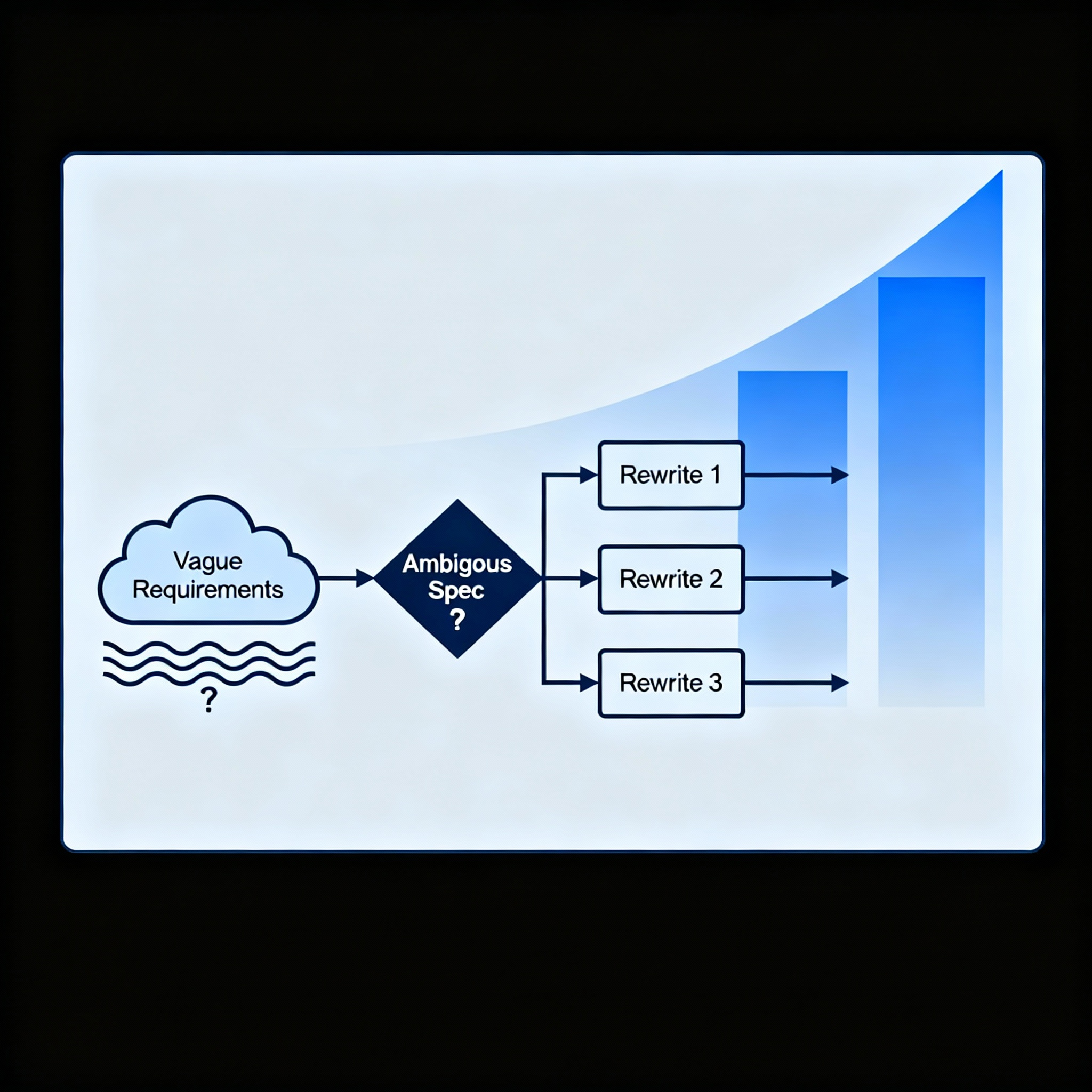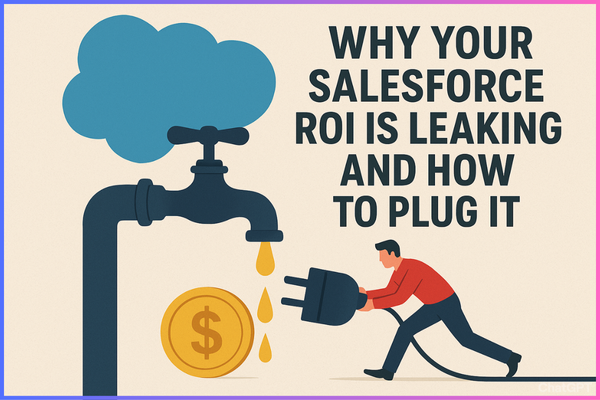Do you remember that business case where a major Salesforce investment, which promised transformative ROI, streamlined operations, and a true 360-degree view of your customer? The excitement was palpable.
So why, six months later, are you staring down the barrel of slipped deadlines, a stretched budget, and lukewarm user adoption?
Technology is not the problem. The issue is a systemic flaw, which we call 'The Delivery Gap'. It is a vast pass between the incredible value promised in the boardroom and the on-the-ground reality of the implementation. It is the gap where your investment’s potential and your ROI, leaks away before it ever reaches your bottom line.
Anatomy of a Leaking ROI Pipe
To truly grasp the Delivery Gap, stop thinking about spreadsheets and start thinking about plumbing.
Picture your ROI as a high-pressure industrial pipeline. At one end, you pour in your entire investment. At the other, you expect an overflow of value to fuel your growth.
But the pipeline itself, your delivery process, is corroded. It is filled with cracks. These are not random drips; they are systemic failures. The three biggest leaks constantly draining your project's potential are Time, Scope, and Adoption. And until you seal them, you are just pouring value down the drain.
Leak #1 - The Time Leak (Delayed Value Realization)
The first and most visible leak in the ROI pipeline is time.
It is not just about pushing a deadline. For every week your project is late, your team is stuck using old, inefficient processes. Your competitors, meanwhile, are closing deals with the very technology you are still waiting to implement. This is the raw definition of opportunity cost.
This is not a rare mishap. The Standish Group’s CHAOS report consistently finds that over half of all major IT projects run significantly behind schedule. You are not only deferring revenue, but also paying salaries and licensing fees for a solution that is not delivering a single dollar of value. The clock is not paused; it is ticking backward against your entire investment.Leak #2 - The Scope Leak (The Exponential Cost of Rework)
This leak is more corrosive. It starts not with a bang, but with a vague phrase in a requirements document, a single assumption that forces your delivery team to guess. When that guess proves wrong, the real cost is not revealed for months. What would have been a five-minute clarification now becomes a cascade of rewrites, re-testing, and stakeholder re-alignment.
There is a long-established rule in software engineering: a bug fixed in production costs 100 times more to resolve than one caught during the requirements phase. It is no surprise that mismanaged requirements are a leading cause of project failure. Every ambiguous spec is a blank check you are handing to rework. You are not just paying for a mistake, you are paying a massive premium for a lack of clarity.

Leak #3 - The Adoption Leak (The Human Factor)
This leak is the silent killer of ROI.
The project is officially ‘done,’ the launch party is over, but the victory is hollow. Why? Because your team quietly reverts to their old spreadsheets and familiar workarounds. The new system, warped by a thousand compromises born from vague requirements and rushed timelines, doesn’t actually solve their real-world problems.
This is not a minor setback; it's a catastrophic failure. Industry reports have consistently shown that up to 70% of all CRM project failures are attributed to low user adoption.
If your people do not use the tool, the business case completely collapses. The data insights, the projected efficiency gains, the entire multi-million dollar investment, it all evaporates into thin air.
Plugging the Leaks - Moving from Hope to a System
So, we have a pipeline bleeding value from delays, rework, and failed adoption. The default reaction from leadership is often to demand more from the team—more hours, more resources, and more heroics from your top performers.
But you can't fix a fundamentally broken process with brute force. These leaks are not the result of a lack of effort; they are the symptoms of a flawed system.
Trying to plug systemic failures with individual heroics is a losing strategy. To truly seal these leaks for good, you must stop patching the pipe and re-engineer your delivery methodology from the ground up.
Solution 1: Treat Documentation as a Strategic Asset
The first and most critical step is to stop treating documentation as an administrative task. The catastrophic Scope Leak is not caused by poor coding; it's caused by ambiguity in the planning phase.
User stories and acceptance criteria are not bureaucratic red tape; they are the architectural blueprints for your entire investment. You would never tolerate vague instructions on a multi-million dollar construction site, so why do we accept them in digital transformation?
Think of crystal-clear, build-ready specs as the most powerful sealant you can apply to your ROI pipeline. Absolute clarity at this stage is not a "nice-to-have", it is the highest form of risk elimination, directly preventing the budget-destroying rework that sinks projects.
Solution 2: Front-Load Intelligence with Metadata Awareness
Building new solutions on an existing Salesforce org without a deep, forensic understanding of its current state is architectural malpractice. Yet, countless projects are derailed by surprises discovered halfway through, directly causing the Time and Scope leaks we have discussed.
The solution is to front-load your intelligence. Before you design the future, you must have a data-driven map of the present. This means leveraging AI to perform a ‘CT scan’ of your org’s metadata to uncover hidden dependencies, identify dormant technical debt, and flagging potential conflicts before they become costly rework.
This approach replaces dangerous guesswork with data-driven design decisions. It ensures your solutions are built on a solid foundation of facts, not fragile assumptions.
Solution 3: Systematize Your Expertise
Every leader has a ‘hero’ on their team, that one superstar architect who can salvage any project. But relying on heroes is not a business model; it’s a bottleneck and a single point of failure. It’s not scalable.
The only way to guarantee consistent, high-quality outcomes is to systematize that expertise. The goal is to codify the knowledge of your best people and embed it directly into your delivery process for everyone to use. This means implementing an AI co-pilot that provides intelligent guardrails, automates best practices, and enables every team member to execute with the precision of your top performers.
This systemic approach is the ultimate leak sealant. It ensures a standard of quality that prevents scope creep, accelerates timelines, and delivers solutions so well-designed that users eagerly adopt them. It finally transforms delivery from an unpredictable art into a repeatable science.

Conclusion: From Leaking Pipeline to Value Engine
The leaks draining your Salesforce ROI are not isolated incidents, they are the symptoms of a systemic Delivery Gap. As we have seen, this gap cannot be closed with heroics or by simply demanding more from your team.
The solution is not about patching holes. It is about a strategic shift, transforming your entire delivery methodology from a reactive liability into a powerful, predictable value engine.
Leaders who embrace this new, systematized approach will stop viewing projects as a risk to be managed and start leveraging delivery as their core competitive advantage.

